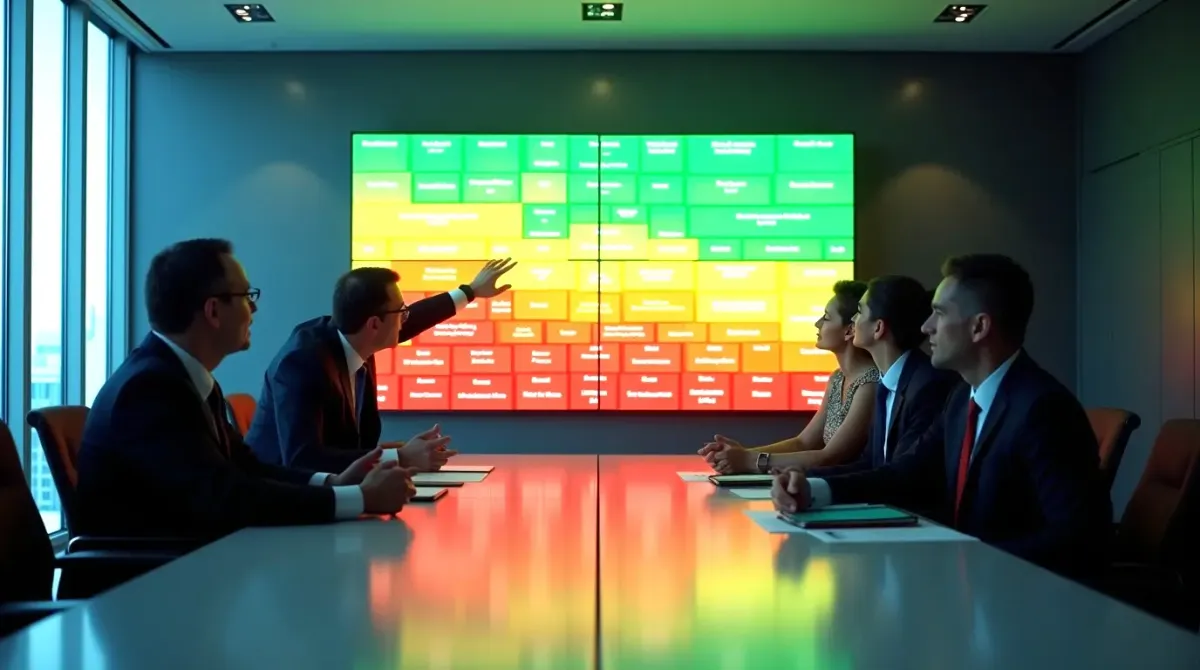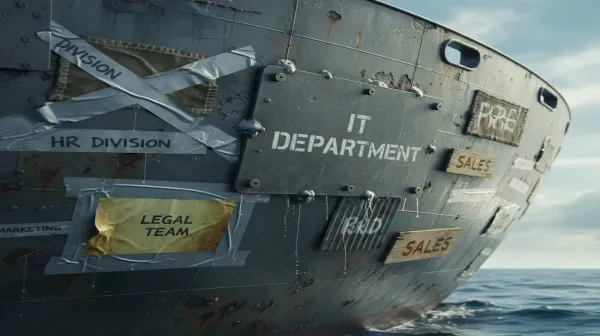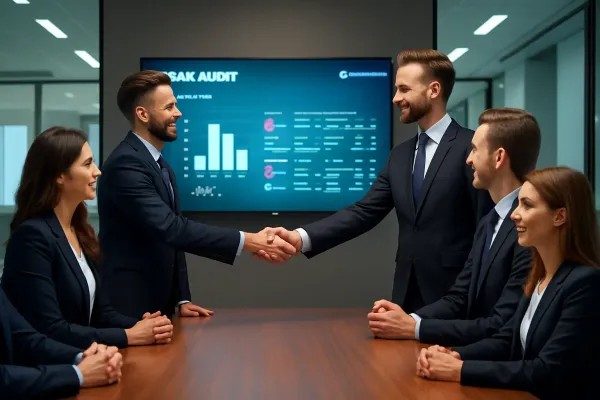Why Risk Assessment Is the Cornerstone of Your TISAX® Success
Your guide to making risk assessment the foundation of your TISAX® success.

Table of Contents
-
Introduction
Why Risk Assessment Is More Than a Checklist
The Real Role of Risk Assessment in TISAX®
The Key Components of an Effective Risk Assessments
Why Management Sign Off Is Essential
When to Start? Earlier Than You Think
Common Mistakes Companies Make
Turning Risk Assessment Into a Competitive Advantage
Get Your IX Risk Assessment Guideline
Introduction
You have written the policies. You have put the technical controls in place. Your documentation is organized and complete. But when the TISAX® auditor arrives, something still does not add up. The feedback is not what you expected. Why? Because somewhere along the way, risk assessment became a checkbox instead of the foundation that supports everything else.
If that sounds familiar, you are not alone. Many automotive suppliers and service providers make the same mistake. They focus on what appears secure instead of identifying what actually protects their most valuable information. The result is often audit findings, frustration, and an Information Security Management System that does not hold up under scrutiny.
Here is the uncomfortable truth: if your risk assessment is not robust, specific to your business, and actively used to guide decisions, then your TISAX® preparation is standing on weak ground.
At the TISAX® Info Hub, we have seen that the companies who succeed take a different approach. They do not treat risk assessment as paperwork. They treat it as the blueprint that shapes their security decisions, their resource allocation, and even their leadership’s involvement in information security.
In this article, you will learn why risk assessment is the foundation of your TISAX® success. You will discover what auditors are actually looking for, how to avoid common mistakes, and how a strong risk assessment can help you stand out as a trusted partner in the automotive industry.
Why Risk Assessment Is More Than a Checklist
Many companies enter the TISAX® process thinking that risk assessment is just another document to submit. Something you write once, attach to your ISMS, and forget about until the next audit. But that mindset is exactly what leads to delays, nonconformities, and unnecessary stress during the assessment.
TISAX® is not a checklist exercise. It is a risk-driven framework based on ISO 27001 principles, tailored to the realities of the automotive industry. That means everything you implement—every policy, every control—must tie back to a real, assessed risk in your business.
Without that link, your security measures are just guesses. You are spending time and resources on controls that may not even address your actual threats. Worse still, when an auditor asks, “Why did you choose this control?” and your only answer is “Because the template said so,” it becomes clear that your ISMS is not rooted in your company’s real-world risk profile.
Treating risk assessment as the starting point, rather than a final task, does more than help you pass an audit. It gives your team clarity. It gives your leadership confidence. And it ensures that the decisions you make today actually protect what matters most tomorrow.
A strong risk assessment is not about perfection. It is about relevance. It is about showing that you understand where your vulnerabilities are, that you have thought critically about how they could be exploited, and that you have taken informed steps to manage them.
If your approach to TISAX® starts with risk, everything else falls into place more easily—and holds up under pressure.
The Real Role of Risk Assessment in TISAX®
Risk assessment is not just a supporting document in the TISAX® process. It is the foundation that everything else is built upon. Without it, your Information Security Management System is disconnected from the real threats your organization faces.
TISAX® is based on ISO 27001, which requires that all security measures be justified by risk. This means your controls should not be chosen because they appear in a standard template. They should be chosen because they reduce or manage a specific risk that you have identified through a structured, well-documented process.
This is exactly what TISAX® auditors are looking for. They want to see that your controls match your risks. If you have access restrictions in place, the auditor wants to know what risk you were addressing. If you have data encryption, the auditor expects to see which threat triggered that decision.
In other words, the auditor is not only checking what you have done. They are checking whether what you have done makes sense in the context of your business.
This is also why companies who skip or rush the risk assessment stage tend to face problems during the audit. If your risk assessment is vague, generic, or disconnected from your actual operations, then your entire Information Security Management System loses credibility.
On the other hand, a clear, specific, and well-documented risk assessment shows that your organization understands its threat landscape and is taking appropriate, responsible action to manage it. That is what builds trust with auditors, customers, and Original Equipment Manufacturers.
The Key Components of an Effective Risk Assessment
A strong risk assessment is not about producing a long document. It is about making sure the right questions are being asked and answered. The goal is simple: identify what needs to be protected, understand what could go wrong, and decide what to do about it. Here are the essential components that must be included in any risk assessment that supports your TISAX® success:
Asset Identification
Start by identifying what your organization needs to protect. This could include sensitive customer data, engineering drawings, prototype specifications, intellectual property, manufacturing systems, or communication channels with partners and suppliers. If you do not define what is valuable, you cannot protect it.
Threat and Vulnerability Analysis
Once your critical assets are identified, the next step is to determine the threats and vulnerabilities that apply to them. These will differ depending on your operations. For example, if you work with prototype vehicles, you may face risks such as industrial espionage or targeted data theft. If you rely heavily on suppliers, you may face third-party risks. This step is about understanding how your business could realistically be compromised.
Risk Evaluation and Prioritization
After identifying risks, assess their potential impact and the likelihood of them occurring. This is where you decide which risks need immediate attention and which can be monitored over time. Not all risks are equal. Some may have a low chance of happening but would cause major damage. Others may be more common but less severe. This evaluation helps you focus on what truly matters.
Risk Treatment Plan
Now that your risks are prioritized, you must decide how to handle them. Some risks can be reduced through controls. Others can be avoided, transferred to third parties, or accepted if they fall within a tolerable level. The important part is that you link each decision to a clear action and, where applicable, to a specific TISAX® control. This shows that your Information Security Management System is actively responding to real risks, not just following theory.
Documentation and Ongoing Monitoring
Your risk assessment is not a one-time document. It must be maintained and updated as your business evolves. Changes such as adopting cloud services, entering new partnerships, or launching new products will introduce new risks. You must also keep a clear record of how decisions were made and who was involved. Auditors want to see that your process is repeatable, consistent, and aligned with your current reality.
When all five components are in place, your risk assessment becomes more than a requirement. It becomes a practical tool for decision-making and a strong foundation for your entire TISAX® strategy.
Get our IX Risk Assessment Guideline
If you want to strengthen your process even further, you can request a risk assessment guideline designed to align with TISAX® expectations. This guideline saves you time, helps you structure your assessment correctly, and ensures that you do not miss any critical elements.
Simply write to ix@isegrim-x.com to receive it.
Why Management Sign Off Is Essential
One of the most overlooked but critical parts of a TISAX® risk assessment is management sign off. This step is not a formality. When senior leadership personally reviews and endorses the results of the risk assessment, it demonstrates that information security is a business priority, not just an information technology compliance task.
Management sign off creates three powerful outcomes:
- It shows that risk assessment is taken seriously at the highest level of the organization.
- It sends a clear signal to auditors that the company is accountable for its security decisions.
- It motivates employees to contribute actively, because they see that executive leadership is directly involved.
Auditors notice when documents lack management signatures. In fact, unsigned risk assessments often raise red flags. A signed risk assessment demonstrates organizational maturity and confirms that security measures are aligned with the overall business strategy.
This combination of a structured template and leadership sign-off can dramatically improve both your audit readiness and your internal security posture.
When to Start? Earlier Than You Think
If you are wondering when the best time is to carry out your risk assessment, here is the answer: at the very beginning of your TISAX® project.
This is not just good advice. It is the kind of advice that makes your life easier later.
Doing your first risk assessment at the start of the project and having it signed off by management right away sets a solid foundation. It gives structure to your security planning, connects your actions to real threats, and brings your leadership on board from the beginning.
Once management signs off, conversations about budget, timelines, and resourcing suddenly become much more straightforward. Instead of trying to justify every request, you are following a shared plan based on agreed risks. It shows that security is a business issue, not just an information technology one.
And here is the clever part. Of course, you will carry out a second risk assessment before the actual audit. This is your opportunity to show just how far you have come. Comparing the initial and final assessments demonstrates how much risk you have reduced for the organization and for management. It proves that your Information Security Management System is not just theoretical. It is effective.
So do not wait until everything else is finished to think about risk. Begin with it. It will guide your decisions, earn leadership support, and give you real progress to show when audit time comes.
Common Mistakes Companies Make
By now, it is clear that risk assessment is not just a formality. It is a foundational activity that influences every part of your TISAX® preparation. Still, many companies stumble here. Not because they do not care, but because they underestimate what the process really involves.
Here are the most common mistakes that can derail your TISAX® efforts:
-
Treating risk assessment as a one-time task
Many organizations complete a single risk assessment, file it away, and never revisit it. That approach does not meet TISAX® expectations. Risks evolve. Your suppliers change. Your technology stack grows. New threats emerge. Risk assessment must be a living part of your Information Security Management System. -
Using generic templates
Templates can help with structure, but they should never replace real thinking. Copying a risk assessment from another company or using a one-size-fits-all format will not reflect your actual environment. Auditors spot this immediately. A template without relevance is not a risk assessment. It is just paperwork. -
Skipping stakeholder involvement
Risk is never limited to the information technology department. Legal, operations, human resources, engineering, and even marketing teams may all introduce or face different types of risk. If you do not involve these stakeholders, you miss valuable perspectives and create blind spots in your analysis. -
Rushing or skipping management sign off
This might seem like a small step, but it has major consequences. Without management sign off, your risk assessment lacks authority. It may also result in limited support for critical actions. And during a TISAX® audit, unsigned documents can lead to findings or additional scrutiny. Auditors want to see that risk management is not just a task, but a commitment shared across the organization.
These mistakes are common, but they are also easy to avoid once you understand their impact. Focus on relevance, collaboration, and ongoing review. When you do, your risk assessment becomes more than just compliant. It becomes useful.
Turning Risk Assessment Into a Competitive Advantage
Many companies see risk assessment as a box to tick on the way to a TISAX® label. But if you shift your perspective slightly, you will find that it can become much more than that. It can become a strategic tool that builds trust, sharpens decision-making, and sets your company apart from the competition.
In the automotive sector, where data security is non-negotiable and supplier scrutiny is increasing, being able to demonstrate a structured, risk-based approach to information security carries real weight. It shows your customers and partners that you understand your risks, manage them actively, and do not just rely on generic best practices.
This kind of maturity is what Original Equipment Manufacturers and large clients look for. They want to work with suppliers who think critically about security, not just those who pass the audit on paper.
Even beyond the audit, a well-integrated risk assessment helps your teams make better decisions. Whether you are choosing a new cloud provider, handling prototype data, or onboarding a third-party supplier, having a clear view of your risks turns uncertainty into structure. It gives everyone a way to ask, "What could go wrong here?" and answer it with facts, not assumptions.
And when management has signed off on the risk assessment from the beginning, it sends a powerful internal message: security matters. Not just at the compliance level, but at the strategic level.
In the end, risk assessment is not about fear. It is about focus. It is how you ensure that your security efforts are grounded in reality, supported by leadership, and clearly aligned with your business goals. That is what leads to TISAX® success. That is what builds confidence with your clients. And that is how you move from simply being compliant to being trusted.
Get Your IX Risk Assessment Guideline
If you want to build your risk assessment on solid ground and avoid the common pitfalls that trip up so many companies, do not start from scratch. Request our detailed risk assessment template, built specifically to support TISAX® success.
It will help you save time, structure your analysis properly, and make sure you cover all the elements auditors expect to see.
Write to ix@isegrim-x.com to request your copy.
Start with the right foundation and set your TISAX® project up for success.




